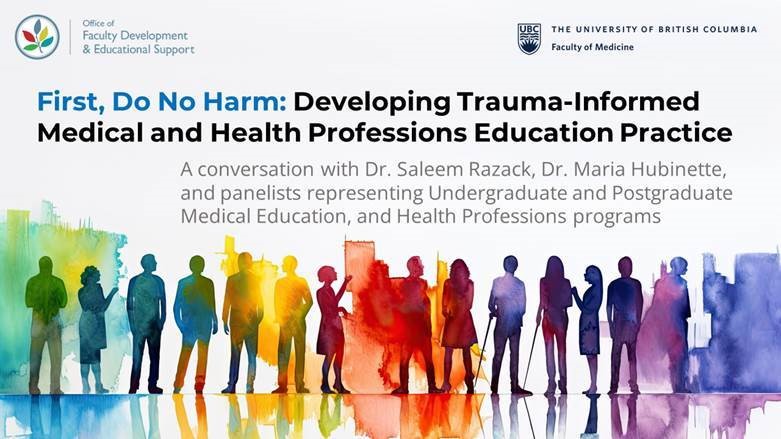Trauma-Informed Education Practice – Cases


Please note that the cases are fictitious but are drawn from experiences that have occurred in the faculty. They may contain details that bring up difficult thoughts and emotions for some participants. Please prioritize taking care of yourself and note your participation in the discussion is always voluntary.
You are also welcome to reach out to us at any time including coming back to the main room to talk with the facilitators if that would be helpful.
Each group has 15 minutes to read through and discuss. Questions have been provided to guide your discussion in key areas.
CASE 1 – Cascade of Disclosure
MD Undergraduate Program – Small Group Context
You are facilitating a small group session with a group of learners. You get delayed in traffic racing from your clinical work, so you arrive a few minutes late to the session. You walk in to find a group of learners, none of whom you know well, animatedly talking with each other. You apologize for being late, and dive right into the agenda/objectives for the session. The previously chatty group immediately quiets and soon it starts to feel like pulling teeth to get a learner to respond to your questions about the social determinants of health, the topic of today’s session. To get them to open up, you state the expectations that everyone needs to participate, you tell them that it is a safe space, and state that everyone therefore should feel free to share.
However, if truth be known, sharing and facilitating is the last thing you also feel like doing. You have had a long day yourself, you are worried about your youngest child who has been struggling lately, but you didn’t want to let the program down so you came. Fortunately, after what feels like a long, awkward silence, a learner begins to share. They describe a clinical encounter they had had that day where they felt a patient was dismissed and not taken seriously because of a past history of a substance use disorder and unstable housing. Another nods in agreement, and admits that when they talk about housing, it makes them feel stressed about their own circumstances—they pay astronomical rent and feel totally overwhelmed by their debt load. Another learners agrees, and chimes in that they feel it is unfair that they are expected to travel all over for their clinical learning/placements, which is expensive, and points out that they feel they are also adding to pollution and worries about the impact on climate health.
When you try to bring the conversation back to the objectives of the session, another learner shares how a patient she saw today reminded her of her mother, who is currently undergoing treatment for lung cancer, and starts to tear up in the group. The group goes silent, you are wondering what to do next, and aren’t sure how to get the group back “on track”.
Areas for Discussion:
-
-
- What aspects of trauma-informed education are relevant in this context/situation? What tensions are at play?
- What are some ways we can support ourselves as educators/teachers, so that we can also be supportive to our learners?
- What are some practical ways to enact trauma-informed education within a small group learning environment?
-
CASE 2 – Stoicism
Post Graduate Medical Education Program – Clinical Teaching Context
You are an Emergency Medicine physician at a busy hospital and your resident arrives to start their shift. You know this resident fairly well, and notice they seem unusually quiet and possibly upset. When you ask them how they are, they start crying and say they had been crying off and on all evening and didn’t sleep well. They share that the day prior, a patient had died in the OR due to a complication. You express your condolences and ask them if they were able to talk to the staff assigned to the case after the event.
They share that after the patient died, the staff had said “This was an unfortunate outcome, but these things happen, and it’s a part of the job. For me, I find the best thing to do is to keep working, so that I don’t get too tied up in my feelings about the case. You should contact the Resident Wellness Office, and I think I saw a webinar coming up on wellness that you should consider going to”.
You know who the attending is and recently overheard them talking about how all of the residents today really need to learn how to tough it out for the duration of their shift. Hearing this story, you want to support the student and have a broader conversation, but you are aware of your own shift starting and the many patients requiring emergent care. You also have learned to ‘put away’ your feelings after a patient death as the workday continues on and the next patient is deserving of your full, undistracted attention.
Areas for Discussion:
-
-
- What aspects of trauma-informed education are relevant in this context/situation? What tensions are at play?
- What are some ways we can support ourselves as educators/teachers, so that we can also be supportive to our learners?
- What are some practical ways to enact trauma-informed education within a clinical learning environment?
-
CASE 3 – Epistemic Injustice
Health Professions – Physical Therapy – Clinical Teaching Context
You are a Physical Therapist, fairly new to practice. You arrive at a rehabilitation centre to work with your first patient of the day, and you have a new physical therapy student with you today. After reviewing your learners goals, together, you approach the patient. Your patient is a middle-aged woman who is recovering from a motor vehicle accident. In previous interactions with this patient, she has become frustrated easily, often raising her voice and wanting to leave mid-appointment when she experiences pain and discomfort. Today, you are hoping you can manage things in a way that they go smoothly.
You enter the room, introduce the student and say that they will be helping with her care today. As the student approaches the patient, the patient puts her hands up is if to block them, and says with a raised voice, “No. Don’t touch me. I don’t want an immigrant student!” The student stops, and you take a moment to think about how to proceed. You know this patient needs this appointment, and you don’t want this to escalate into her leaving again. You intervene, and say “It’s okay, please don’t worry, we’ll have the student leave for the duration of your appointment.” You nod to the student to leave, fully intending to connect with them after the appointment.
When you find them, you apologize to the learner, acknowledge that must’ve been hurtful. You ask them if they are okay as you walk to your next case. The student says they are fine, and that this has happened to them before.
Areas for Discussion:
-
- What aspects of trauma-informed education are relevant in this context/situation? What tensions are at play?
- How can we create spaces to address such scenarios with patients?
- What are some practical ways to enact trauma-informed education within a clinical learning environment?